Project on Los Angeles Department of Water and Power Land
October 10, 2010 - From http://www.ladwp.com/ladwp/cms/ladwp013701.jsp#P12_498
The City of Los Angeles Department of Water and Power (LADWP) is proposing the Southern Owens Valley Solar Ranch (SOVSR) project that would be a 200 megawatt (MW) net generating capacity solar energy facility using photovoltaic (PV) panel modules.
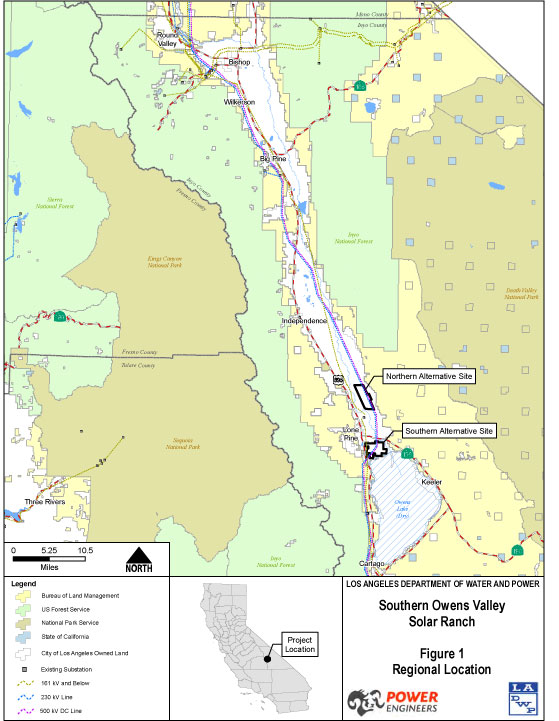
Concerns include dust generation, cultural and archaeological sites, and visual impacts among many others. With Mt. Whitney and the Alabama Hills near the proposed sites and with tourism as the primary economic engine in Southern Inyo County, these solar industrial sites have the potential to affect the local economy negatively.
Project Location
Two potential sites for SOVSR are under consideration, each consisting of about 3,100 acres and each located on property entirely owned by the City of Los Angeles. Only one of these sites would be developed under the proposed project but both sites will be analyzed in the EIR. The northern alternative site is located northeast of the town of Lone Pine and west of the old train town of Owenyo, in Inyo County, California (see Figure 1: Regional Location and Vicinity Map and Figure 2: Northern Site Plan). The southern alternative site is located south of the town of Lone Pine and immediately northwest of the Owens Dry Lake (see Figure 3: Southern Site Plan). Both sites are located adjacent to regional transmission lines owned and operated by LADWP.
Purpose and Need
As a result of the California Global Warming Solutions Act (Assembly Bill 32, 2006) and subsequent related bills, executive orders, and mandates, LADWP is committed through its Renewable Portfolio Standard (RPS) to generating 35 percent of its retail electric energy sales from renewable energy resources by the year 2020. As of mid-2010, LADWP had established a renewable project portfolio amounting to about 19 percent of its total electrical demand, which is approaching LADWP’s interim 2010 objective of 20 percent of electrical sales met through energy generated from renewable sources. Other pending state and federal legislation may require LADWP to meet additional interim RPS goals prior to the 2020 targets.
The City of Los Angeles continues to aggressively pursue all available avenues to reduce use of fossil fuels for energy production, including conservation programs, solar incentive programs (including in-city rooftop solar), construction and acquisition of wind power, and development of geothermal, biomass, and small hydroelectric power sources. To meet the year 2020 renewable standard, LADWP must increase renewable generation by another 15 percent over current levels and at the same time accommodate growth. According to the Southern California Association of Governments, population in Los Angeles is projected to increase by about 550,000 people between 2000 and 2025, resulting in an average increase of 62 MW in required generation capacity per year. To meet this demand and achieve the state’s aggressive renewable energy goals, LADWP must continue to pursue a range of renewable energy prospects, including large-scale renewable power projects such as the proposed SOVSR.
The Owens Valley possesses excellent solar energy production potential. Based on data from the U.S. Department of Energy’s National Renewable Energy Laboratory (NREL), much of the floor of the Owens Valley has solar resource potential greater than or equal to six kilowatt hours per square meter per day. This resource potential is considered suitable to support commercial-scale solar development. Coupled with a slope of less than three percent and the ability to assemble parcels of one square kilometer or more, the valley floor has a high level of suitability for implementation of a commercial-scale solar development.
Considering solar resource potential and the use of PV solar technology, it is estimated that the proposed project’s renewable energy contribution would be approximately 440 gigawatt hours for the first year after the commercial operation date is reached, and, due to the nature of solar PV technology, would decline at 0.5 percent per year thereafter. The energy would be produced primarily during the day and used to meet peak demand periods for power. This amount of energy is enough to serve approximately 75,000 households and reduce emissions of carbon dioxide by about 285,000 tons annually. When implemented, the project will contribute about four percent renewable energy towards LADWP’s 2020 RPS goals.
Proposed Action
The project involves development of a net generation capacity of 200 megawatts of solar photovoltaic electrical energy and associated equipment within an approximately 3,100-acre area in the southern Owens Valley in Inyo County, California. The solar modules would produce direct current (DC) energy, which would be converted to alternating current (AC) energy usable in the LADWP transmission and distribution system. Overall, the net generating capacity of the proposed project will be 200 MW, which would be the AC output from the substation. Please see Figure 2 and Figure 3 for conceptual site plans. No new regional transmission lines are anticipated for the proposed project.
PV Modules and Electrical Equipment
LADWP is evaluating several different solar PV technologies and has yet to decide which technology would be utilized for the project; however, it is likely to be either thin film or crystalline silicone PV solar cells. With both of these technologies, a number of individual solar cells are linked together (in series) and housed within an individual solar panel module. The modules are then grouped onto lightweight steel or aluminum frames and arranged into larger arrays to form a power block of approximately one MW in capacity. Each one-MW block would cover approximately eight acres (see Figure 4: Typical One-MW Power Block Layout). For construction and operational purposes, the power blocks would be combined into 50-MW power units of approximately 400 acres in size, as shown on Figure 2 and Figure 3. Overall, the project would provide 200 one-MW power blocks (four 50-MW power units).
Each one-MW solar power block would include one to two inverter units to convert DC to AC, and a transformer unit. The project may employ a single transformer unit at each power block that integrates the transformers and inverters.
Power from each 50-MW power unit would be collected via underground cables and conveyed to power collector stations, and then transmitted via underground cable to a single PV integration station. At this point, power from the entire project would be combined and conveyed via overhead transmission line to the proposed electrical substation.
Operations and Maintenance Building
A 3,000 square-foot steel operations and maintenance building would be located at the project site and used for equipment storage and maintenance procedures. The operations and maintenance building site also would include parking, secure exterior storage, water supply, and a perimeter fence.
Substation
An electrical substation would be provided to step up the power produced by the project from 34.5 kV to the proper voltage for transmission from the site (most likely 230 kV). The finished size of the project substation would be approximately 500 feet by 300 feet, or about 3.5 acres. Tentative locations of the substation for northern and southern alternative project sites are identified on Figure 2 and Figure 3.
Construction
It is anticipated that construction for the project would begin in July of 2012 and be completed by June of 2015. The total duration of construction would be approximately 36 months.
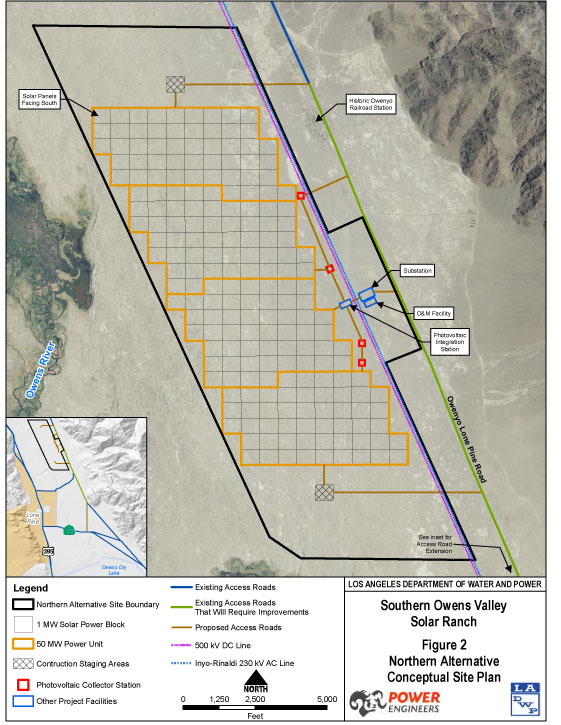
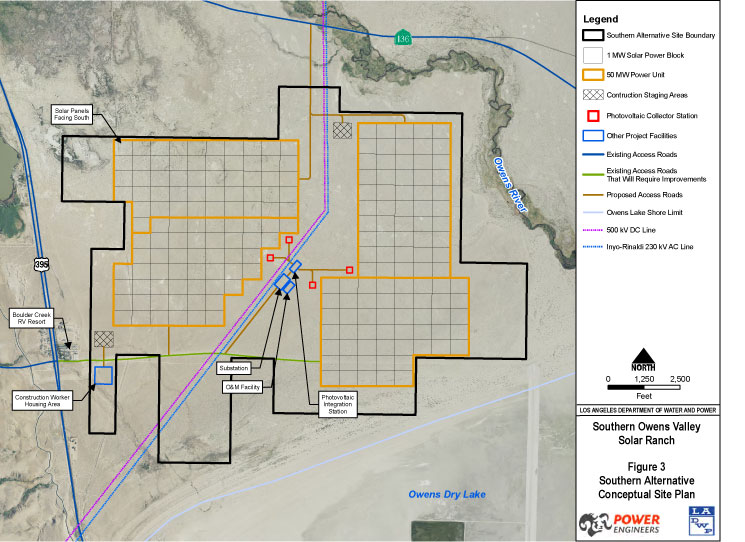
Environmental Review
LADWP will be the Lead Agency and will prepare an Environmental Impact Report (EIR) pursuant to the California Environmental Quality Act (CEQA) for the proposed project. The EIR will identify the short-term, long-term, and cumulative environmental impacts resulting from construction and operation of the proposed SOVSR.
All CEQA environmental resource issue areas will be addressed in the EIR and include the following: aesthetics/visual resources; agricultural and forestry resources; air quality; biological resources; cultural resources; geology and soils; greenhouse gas emissions; hazards and hazardous materials; hydrology and water quality; land use; mineral resources; noise; population and housing; public services; recreation; traffic and circulation; and utilities and service systems. However, the level of analysis to be included may vary based on complexity of the issues, public and agency input, and/or refinements to the project description. The EIR will include all topical areas of content required by CEQA, such as alternatives to the proposed project and growth-inducing impacts. For impacts that are significant, mitigation measures will be proposed to alleviate or avoid the significant impact(s).
LADWP intends to evaluate the environmental impacts of the northern and southern alternative sites equally and then select one site for solar development. Other alternatives to the proposed project would be developed as the environmental evaluation progresses and with consideration of public, agency, engineering, and environmental staff input.
All public documents related to the CEQA review process for the SOVSR will be available at this website. Agencies, elected officials, organizations, Native American Tribes, and interested individuals were sent a Notice of Preparation (NOP) on September 30, 2010.
Public Scoping Meetings
Scoping is a process for determining the issues to be addressed, and identifying the range of actions, alternatives, mitigation measures, and significant effects to be analyzed in depth in an EIR. A public scoping meeting will be conducted to inform the public, agencies, organizations, and interested parties about the proposed project, purpose and need, and environmental review process. The date, time and location are listed below:
LADWP Southern Owens Valley Solar Ranch EIR Scoping Meeting:
Thursday, October 28, 2010
6:30 PM to 8:30 PM
Statham Hall
138 Jackson Street
Lone Pine, CA 93545
LADWP is requesting input from individuals, stakeholders, organizations, and agency representatives that may be interested in the proposed project as to the scope and content of the environmental information to be included in the project EIR. The public comment period for the NOP will start on October 1, 2010, and end on November 15, 2010, lasting approximately 45 days. Please send comments to Ms. Shilpa Gupta at the address, email, or fax number below. Comments letters must be postmarked on or before November 15, 2010 and that email and fax transmittals sent prior to the close of business (5:00 p.m.) on November 15, 2010. You may also leave messages on the toll-free phone line at (888) 362-6016.
Ms. Shilpa Gupta
Environmental Planning and Assessment
Los Angeles Department of Water and Power
111 North Hope Street, Room 1044
Los Angeles, CA 90012
Email: shilpa.gupta@ladwp.com
Phone: (213) 367-0610
Fax: (213) 367-4710
Project Timeline
Scoping Meeting: October 28, 2010
Public Comment Period for NOP: October 1 – November 15, 2010
Notice of Determination: Early 2012
Design/Engineering: 2012
Construction: 2012 – 2015
Target In-Service Date: Fall 2015
Additional Project Information
The NOP, which contains additional preliminary project details, may be found at the following locations:
1. Lone Pine Branch Library
Lone Pine, California 93545
(corner of Washington & Bush Streets)
(760) 878-0260
2. Big Pine Branch Library
500 South Main Street, PO Box 760
Big Pine, California 93513
(760) 938-2420
3. Independence Branch Library
168 North Edwards Street
Independence, California 93526
(760) 878-0260
4. LADWP - Bishop Operations Office
300 Mandich Street
Bishop, California 93514
(760) 872-1104
http://www.ladwp.com/ladwp/cms/ladwp013701.jsp#P12_498
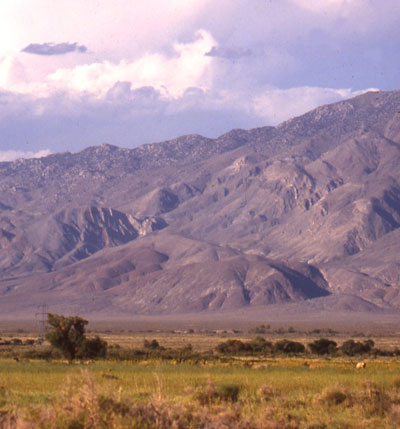
^Vicinity of the northern alternative project site, southern Owens Valley.
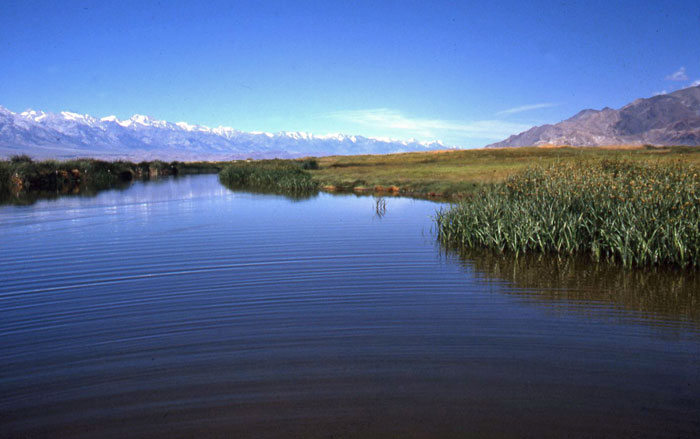
^Springs near the southern project alternative site at Owens Lake.
HOME.....Owens Dry Lake
